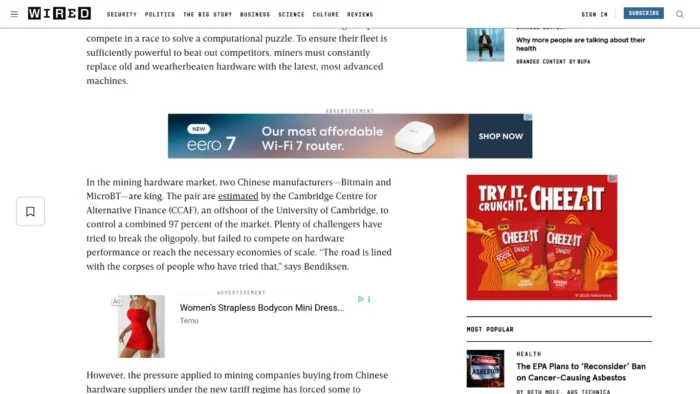Understanding the 11 Major Types of Copywriting (Infographic)
You may be a copywriter without even knowing it. Here are nine major types of copywriting you can use for your next marketing strategy.

What we know as copywriting today is not altogether new. Copywriting is one of the oldest professions known in history.
Mark Tungate in his 2007 book Adland notes that there are promotional pamphlets found as far back as Pompeii promoting a new brothel in town. Tungate even noted that some cave drawings could be interpreted as promotional material.
Copywriting has evolved from cryptic images on a wall to messages shared all over the world. You can find copywriting just about everywhere you look.
But which types of copywriting should you pay attention to when creating your marketing campaign? Here are the eleven major types and why they matter.
Table of Contents
Marketing CopywritingSEO CopywritingEmail CopywritingSocial Media CopywritingWebsite CopywritingDirect Response CopywritingBrand CopywritingPublic Relations CopywritingThought Leadership CopywritingProduct and SalesTechnical Copywriting
1. Marketing Copywriting
This is the type of copywriting that people are most familiar with. Marketing copywriting can be anything you see and hear that is promotional in nature.
Marketing copywriting includes:
Online display ads.YouTube videos.Radio commercials.TV commercials.Flyers.Billboards.Branded stickers.Direct mail.Marketing copywriting can come in the form of paid advertisements or traditional marketing assets. They are clear sales-driven pieces of content that have an obvious goal of trying to sell.

Kate Spade’s ad demonstrates marketing copywriting by its copy written at the top of this Facebook ad. They opted for lower-case type for an on-brand writing style and immediately offered the discount to prompt their prospect to click on the ad. This advertisement is clearly created with the intent of selling their purses in this example.
Marketing copywriting is a tried and true way to communicate new products to potential customers. You can use a targeted paid ad like this Adidas promotion or reach a broader audience with a billboard or a radio commercial. As long as it is part of a marketing campaign, it is considered marketing copywriting.

2. SEO Copywriting
SEO copywriting involves optimizing copy using keywords and phrases for search engines to more easily discover the copy and list it as a top result. A sales page can be optimized for a search engine results page (SERP) if done correctly.
This page from Hatfield includes SEO copywriting that is selling the company’s products while using keyphrases to optimize the page for a top SERP spot.

3. Email Copywriting
Among the many reasons to use email marketing, writing great email copy is the one of best ways to directly connect with your most targeted audience. There are many methods for writing great email copy that works with your marketing campaigns and your customers.
Email copywriting includes:
A great subject line.A thoughtful preview sentence.An intro sentence for the body of your email.A compelling CTA.
This email from Wanderlust is promoting the company’s meditation webinar. The subject line for this email is “Don’t hesitate, meditate!” It’s an attention-grabbing subject line that is sure to stand out in the sea of emails for anyone’s inbox.
The image included in the email has the title of the webinar, the duration of the challenge and the host’s name. Following the key information is another eye-catching headline that urges subscribers to keep reading.
Email copy can be both educational, as with newsletters and roundups, or more sales-oriented in nature, like a direct response or free trial promotion.
B2B email copy is a little different from B2C in a few ways:
Write for a logical buying process vs. emotional.Build a personal relationship with the subscriber.Open up the email to engage in conversations.Utilize more industry terminology.Here is a sales email from Exectras. The email’s opening two lines speak directly to the customer’s questions and pain points, followed by a direct outlining of the nature of their service offering.

You may notice that the email isn’t overly image-heavy — B2B email copy aims to get to the point quickly. Businesses go through a longer buying process because they need to consider budgets and how the purchase will affect their business. To which, a B2B copywriter should engage subscribers on a more logical basis to support an argument for making the purchase. This includes why the price of the product is justified, how it will help their business and the ways this collaboration could be leveraged in the future.
People who subscribe to your email list are some of your most valued prospects. They subscribe because they want to stay informed on your business’ new products and services. Writing email copy can be muddled with trials and errors, but direct communication with your subscribers is invaluable.
Subscribe to
The Content Marketer
Get weekly insights, advice and opinions about all things digital marketing.
Thanks for subscribing! Keep an eye out for a Welcome email from us shortly. If you don’t see it come through, check your spam folder and mark the email as “not spam.”
There are many different social media platforms you can use to communicate with your audience. Doing research to find out where your customers are spending their time will help you write the right message for them.
Based on that research, you can tailor the voice and tone of your social media copywriting to speak to your audience effectively.
Smashburger is known to have funny, endearing social media posts because its audience is a younger generation of fast-casual diners who love great food. While the restaurant’s posts commonly depict young families enjoying a Smash burger meal accompanied by brand-nuanced copy, they don’t shy away from some comedic copywriting to engage their audience:

Writing social media copy involves a few distinct elements because of its audience. Here are a few ways this type of copywriting is different:
Emojis are widely used and accepted.An informal tone is more accepted.Your copy is usually paired with a visual component.You may be writing for paid ads across several platforms.KPIs are measured differently on each platform.Your ad will redirect to your website’s landing page directly.Your copy should be brief.Because of these key factors, focus on shareability and clearly show that you understand who your audience is when you’re writing copy for social media.
The structure of a social media post is also distinct. Whether or not they’re sponsored, most posts you’ve seen on social media have something visual like a picture, informational copy and promotional copy. And notably, social media copy can be used for both B2B and B2C marketing strategies.
5. Website Copywriting
From the top-of-funnel appeal of a high-level, engaging article explaining a product to a highly targeted service landing page that speaks directly to those on the bottom-of-funnel, website copywriting is utilized by companies of all sizes and industries to communicate their offerings.
Website copywriters adopt a handful of best practices and considerations: brand tone, SEO-friendliness and applicable CTAs among them. Further still on best practices, excellent website copywriting conveys a clear message about the brand and its products and services while also encouraging readers to take that next step down the funnel — whether that’s to sign up to an email list, consider subscribing or to make a purchase.

This website copywriting from Saphisle, worked out by the team at Brafton, takes an in-depth service offering and communicates it in simple, appealing language — accompanied by clear CTAs. The way the copy is laid out encourages readers to navigate to the landing page that best suits where they are on the consumer funnel.
6. Direct Response Copywriting
Direct response copywriting is a type of communication that is compelling enough for the customer to take action. It is any form of copy that encourages the recipient to take an action right away.
Direct response copywriting can be used in:
Landing pages after clicking on an ad.Open-ended emails.Pop-ups.Limited time offer explanations.
You’ll find here that Nuuly’s landing page has its logo, slogan and several CTAs that ask for an action. “Join Now” is the direct response button that will move the customer along in their sales process.
Oftentimes, as a customer scrolls through a website, a pop-up will appear before changing pages or exiting out. This is another form of direct response prompting them to stay on the page by signing up for something the company offers.

These are great ways to see more responses from your customers. Sometimes all a customer needs to purchase or download your eBook is the CTA button or form inviting them to do so.
7. Brand Copywriting
Communicating what your brand represents is a big part of gaining recognition in your industry and connecting with customers. You can do that through writing with a specific image of your brand in mind. It can come in the form of a logo, theme song, phrase or a brand personality trait.
However, this image must resonate with your audience or else it will fall short. For brand copy to work, the customer needs to stay at the top of your mind. Take this brand copywriting from AirBnB for example — one that engages both the heart and mind.

Via Medium.
While knowing your audience is helpful, you can gather feedback on your brand copy through a series of trials, such as:
Audience surveys.Focus groups.Blind testing.A/B testing.8. Public Relations Copywriting
Through a uniform structure and journalistic voice, public relations copywriting aims to inform media publications and the public with a pointed directive of promoting a business, product or service. It’s often written by a public relations specialist. They write about an event from their organization and share the copy with several different media outlets.

Public relations copywriting can be found on sites like PR Newswire, but the same story could be shared through news outlets and radio shows if it gets picked up. It works to form a relationship with the public and organizations in a direct communication medium via news media organizations.
The audience for a press release is specific to B2B reach like:
A journalist looking for leads.An entrepreneur looking to invest.A business owner doing research.Although customers will eventually get the information in the press release, press releases are typically written for B2B marketing.
9. Thought Leadership Copywriting
Thought leadership copywriting comes in many forms but is usually from a prominent figure in an industry. If a top healthcare executive came out with an article recommending the public to adopt a new type of personal care practice, that article would be known as thought leadership copywriting.
This type of copywriting can be written for B2C markets, as well as for the general public. The articles are generally put together by writers who use the well-known news medium to communicate their thoughts on a particular issue. It amplifies their opinions on said issue and gains authority as an expert on that topic.

Take this article on Search Engine Land, for example, where Danny Goodwin — Search Engine Land’s Managing Editor — expressed his opposition to an article put out by The Verge which conflates SEO specialists with the downfall of the internet. Beyond serving as a rebuttal, it also gave Danny Goodwin an opportunity to provide thought leadership for SEO more generally.
While thought leadership copywriting isn’t selling a product, it is urging readers to believe in a particular subject.
10. Product and Sales
Product and sales copywriting encompasses the online description of a product or service, brochures, product catalogs and packaging labels, among other forms — naturally, anything that is intended to bring about the purchase of a product or service.
The nature of product and sales copy in more traditional forms of writing — whether that of newspapers, magazines or print media more generally — hasn’t changed too significantly compared to the copywriting involved in more conventional channels. At its core, product and sales copywriting is about crafting persuasive messages based on an in-depth understanding of the consumer, intended to bring about an intended end — generally, the sale of a product or service.

Semrush’s product catalog is to-the-point, easy to navigate and draws on action-oriented, persuasive language. Through their copywriting, businesses are crystal clear on what they stand to gain through Semrush’s service offerings, and are promoted to take action via direct CTAs.
11. Technical Copywriting
Technical copywriting is a piece of copy that aims to explain technology (like cloud-based technology) while selling a product (like IBM’s new Mono2Micro).

To sell a technical product, copywriters must first explain what it is, how it works and why customers should buy it instead of a competing product. Then, once the customer understands the product, they’re able to decide whether to buy or not.
Industries in the tech world are constantly changing and upgrading their products. Technical copywriting helps the business of tech progress.

This is a sales page for IBM’s Cloud Infrastructure. Compare this sales page to that of the clothing brands Nuuly or SunChild above. Neither of these brands includes FAQ sections for their products because clothes are easy to understand. To demonstrate the importance of IBM’s new cloud services, the customer will likely need more information on how the service addresses their needs before they make a purchase.
A Deeper Look Into Website Copywriting
Website copywriting comes in a handful of forms, each with their own associated nuance and best practices. The way a copywriter crafts copy for a consumer is different from that of targeting a business. Further still, copy that appeals to an organization differs from that which is appealing/relevant to government organizations. Broadly speaking, and applying to content marketing more generally, we can split website copywriting into three forms: B2B (Business to Business), B2C (Business to Consumer) and B2G (Business to Government).
B2B
B2B copywriting generally focuses on the utility of a product and/or service and its specific application to another company. Whether it’s Microsoft advertising their cloud computing services or IBM marketing their enterprise-level software solutions, B2B copywriting often emphasizes the technical specifications, efficiency and cost-effectiveness of an offering.
B2C
B2C copywriting is a form of content marketing that speaks directly to the customer, aiming to invoke emotion, establish a relationship, invoke credibility and ultimately prompt an action. While the nature of B2C copywriting is ultimately determined by a company’s industry and target audience, it differs — generally speaking — from B2B copywriting in that it often relies less on selling efficiency and cost-effectiveness, and more on creating a connection with a niche’s occupants. It’s copy that is often persuasive, story-oriented and emotion-evoking, among other means of establishing connection and prompting action.
B2G
B2G copywriting is oftentimes more technical and formal compared to its B2B and B2C counterparts, as it not only considers the specific needs of government organizations but also the associated legislation, regulations and protocols of such audiences.
That’s not to say B2G copywriting ought to be dry, however. B2G copywriting still adopts persuasive, creative copywriting methods and clear, convincing call-to-actions to clearly communicate an offering and drive the call-to-action.
Becoming a Successful Copywriter
Writing copy is a creative and fun process for connecting with your audience and promoting your organization’s products and services. A copywriter is someone who knows the most about their buyers. While not every piece you write has to be as iconic as a brothel promo from 70’s AD Pompeii, it should make every effort to speak to the people who like your product.
If you think you don’t have any copywriting experience, you might be surprised that you do. Think of the times you’ve written a cover letter, emailed someone asking if they want to go on a trip with you or sent a text urging a friend to try a new facial cream you got that actually helped.
Copywriting involves making a case for something that you want people to buy into, in a way they can get on board with. Your cover letter has a formal tone and supporting arguments for why you should be hired. Meanwhile, a text to your friend about your new cream will be more laid back and personal.
When you write copy, keep in mind that you’re writing for whoever is reading it, not necessarily the business you’re working with.
In Ann Handley’s 2014 book Everybody Writes, she says writing is “part habit, part knowledge of some fundamental rules, and part giving a damn.” You don’t have to be a Pulitzer Prize winner to write great copy; you just have to step into the shoes of who you’re writing for and practice speaking to them.
Some skills a great copywriter has are:
Empathy for the reader.Research-based writing skills.Ability to take criticism.Capacity to write the same thing in different ways.Knowledge of grammar rules.Drive to practice writing almost every day.A great way to get started is as a freelance copywriter or asking your department leader to take on a few writing projects. Any way you can receive direct feedback is helpful to learn where you can grow as you build a writing portfolio.
And, as Handley says, it’s all about getting your hands moving to the point where “the typing becomes writing.”
On the other hand, you could always hire a copywriter or outsource one to fill your needs. An experienced writer could make all the difference in your marketing campaign if you’re looking for great results, fast.
Editor’s Note: Updated November 2023

 MikeTyes
MikeTyes 









![23 Simple Email Marketing Tips to Improve Your Open and Clickthrough Rates [+HubSpot Blog Data]](https://blog.hubspot.com/hubfs/email-marketing-tips-for-small-businesses.jpg#keepProtocol)


















.jpg&h=630&w=1200&q=100&v=6e07dc5773&c=1)



